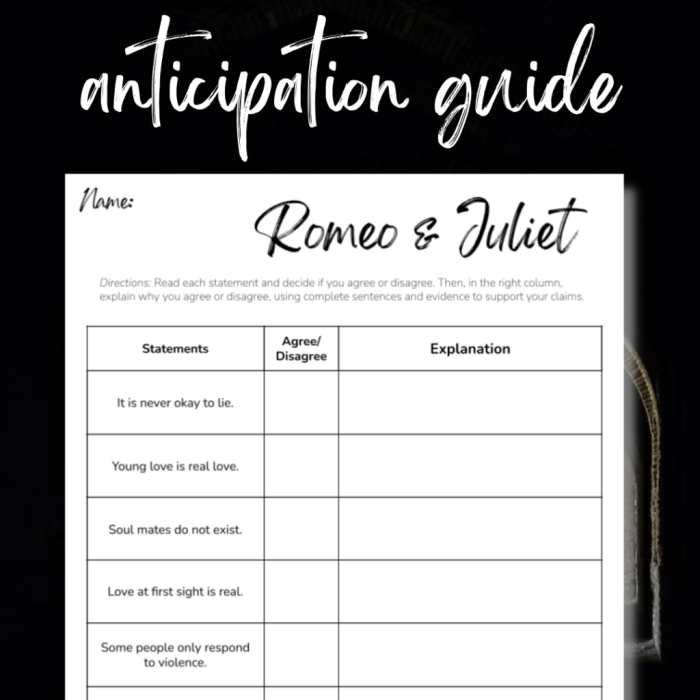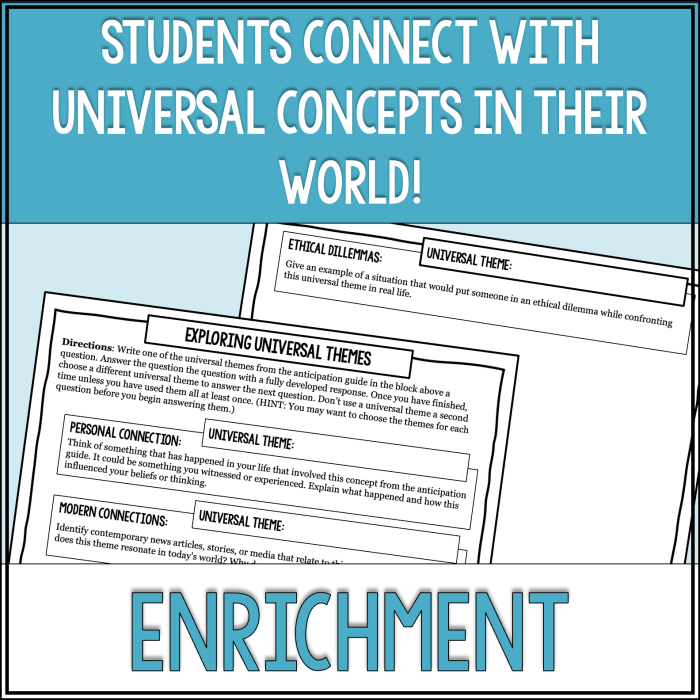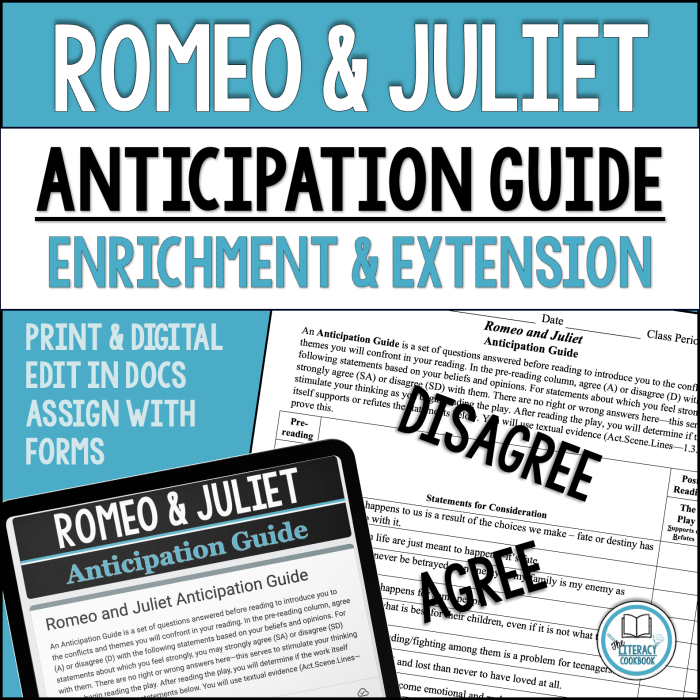The Romeo and Juliet Anticipation Guide provides an engaging framework for exploring the complexities and themes of Shakespeare’s renowned play. This guide invites readers to delve into the story’s characters, conflicts, and enduring messages, fostering a deeper understanding and appreciation of this timeless tragedy.
As students embark on their journey through the play, they will be prompted to make predictions, track their reactions, and reflect on the play’s themes and messages. This guide serves as a valuable tool for enhancing comprehension, fostering critical thinking, and encouraging meaningful discussions about the human condition.
Introduction

An anticipation guide is a pre-reading strategy that helps students activate prior knowledge, make predictions, and set purposes for reading.
It consists of a series of statements related to the topic of the text that students respond to before and after reading.
Romeo and Juliet Overview
Romeo and Juliet is a tragedy written by William Shakespeare early in his career about two young star-crossed lovers whose deaths ultimately reconcile their feuding families.
It was among Shakespeare’s most popular plays during his lifetime and, along with Hamlet, is one of his most frequently performed plays. Today, the title characters are regarded as archetypal young lovers.
Before Reading: Romeo And Juliet Anticipation Guide

To prepare for reading Romeo and Juliet, it is helpful to consider some of the play’s key themes and characters. This will help you to understand the play’s plot and characters as you read it.
Anticipation Guide
Before you begin reading the play, read the following statements and indicate whether you agree or disagree with each one. You may want to discuss your responses with a classmate or group.
| Agree | Disagree |
|---|---|
| Romeo and Juliet is a tragedy. | |
| The Montagues and Capulets are equally to blame for the tragedy. | |
| Romeo is a romantic hero. | |
| Juliet is a passive character. | |
| The play is still relevant to audiences today. |
During Reading

As students delve into the captivating narrative of Romeo and Juliet, it is crucial to foster their active engagement with the text. To facilitate this, provide them with a table or worksheet that allows them to track their predictions and reactions throughout their reading journey.
This tracking tool will serve as a valuable resource for students, enabling them to record their initial expectations, compare them to the actual events that unfold, and reflect on how their predictions evolved as they progressed through the play.
Tracking Predictions and Reactions
The tracking table or worksheet should include the following columns:
- Expected Outcome:Students will record their predictions about what they anticipate will happen in the upcoming scenes or acts.
- Actual Outcome:As they read, students will note what actually occurs in the play, comparing it to their predictions.
- Changes in Predictions:Students will have the opportunity to document how their predictions have shifted or changed based on the unfolding events.
After Reading
Upon completing the play, it is essential to engage students in a discussion about their predictions and reactions. This allows them to reflect on their initial expectations and how the play challenged or confirmed them.
Furthermore, the themes and messages of the play should be discussed in depth. Romeo and Juliet is a tragedy that explores the consequences of impulsive love, family feuds, and societal pressures. Through the characters’ experiences, students can learn about the importance of understanding and empathy, the dangers of prejudice and hatred, and the devastating effects of violence.
Student Predictions and Reactions
During the discussion, students should share their predictions and reactions to the play. Some may have correctly guessed the tragic ending, while others may have been surprised by the events that unfolded. It is important to encourage students to explain their reasoning and to consider how their expectations influenced their reading experience.
Challenging and Confirming Expectations
The play challenges some expectations while confirming others. For example, many students may expect Romeo and Juliet to live happily ever after, but the tragic ending challenges this expectation. However, the play also confirms the expectation that love can be powerful and transformative, even in the face of adversity.
Themes and Messages
- The importance of understanding and empathy: Romeo and Juliet’s tragedy is a result of their inability to understand each other’s perspectives and the consequences of their actions.
- The dangers of prejudice and hatred: The feud between the Montagues and Capulets is a symbol of the prejudice and hatred that can divide people and lead to violence.
- The devastating effects of violence: The deaths of Romeo and Juliet are a reminder of the devastating effects of violence and the importance of finding peaceful solutions to conflict.
Extensions

This play offers endless opportunities for students to engage with its themes and characters in creative and thought-provoking ways.
Encouraging students to explore extensions beyond the text can deepen their understanding and appreciation of the play’s enduring relevance.
Modern Adaptation, Romeo and juliet anticipation guide
Have students create a modern adaptation of the play, transposing the story to a contemporary setting. This activity allows students to explore the play’s themes and characters in a relatable and relevant context.
- Students can choose to adapt the play to a different time period, such as the present day or the future.
- They can also choose to adapt the play to a different culture or setting, such as a different country or a different social class.
Sequel
Have students write a sequel to the play, exploring what happens to the characters after the events of the original play.
- This activity allows students to use their imagination and creativity to extend the story and explore the characters’ lives beyond the play’s tragic conclusion.
- Students can choose to write a sequel that is set in the same time period as the original play or in a different time period.
- They can also choose to write a sequel that focuses on the same characters or on different characters.
Historical Context
Have students research the historical context of the play, exploring the social, political, and cultural factors that influenced Shakespeare’s writing.
- This activity allows students to gain a deeper understanding of the play’s setting and the world in which the characters lived.
- Students can research topics such as the Elizabethan era, the Italian Renaissance, and the history of Verona.
- They can also research the social customs, religious beliefs, and political structures of the time.
FAQ
What is the purpose of an anticipation guide?
An anticipation guide activates prior knowledge, generates interest, and sets the stage for deeper comprehension of a text.
How does the anticipation guide engage students during reading?
Students track their predictions, note their reactions, and reflect on how their understanding evolves as they read.
What are the key themes explored in the Romeo and Juliet Anticipation Guide?
Themes include love, conflict, fate, family, and the human condition.